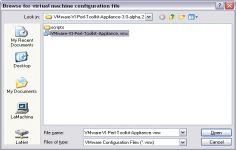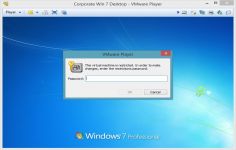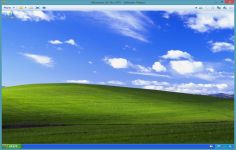 VMware Player 2.5.0
VMware Player 2.5.0
VMware Inc - (Freeware)
Sharing data between host computer and virtual machine is very much possible with VMware Player which makes all very easy.
VMware Player is a software program that allows having multiple operating systems on one computer using more virtual machines. It helps to easy operate any virtual machine created by VMware Workstation, VMware Fusion, VMware Server or VMware ESX, as well as Microsoft Virtual Server virtual machines or Microsoft Virtual PC virtual machines.
With this tool it is possible to create virtual machines and install an operating system without leaving the main system.This program can be very interesting to go from one OS to another to test the compatibility of professional software or for beta testers who can work easily on a given and contained in a virtual machine configuration.
- Title:
- VMware Player 2.5.0
- File Size:
- 65.2 MB
- Requirements:
- Windows 2000 / XP / Vista / Windows7 / XP64 / Vista64 / Windows7 64 / Windows8 / Windows8 64
- Language:
- en-us
- License:
- Freeware
- Date Added:
- 23 Sep 2008
- Publisher:
- VMware Inc
- Homepage:
- http://www.vmware.com
- MD5 Checksum:
- E94F1BE6A96867419BF31E42BE12F29C
New Support for 32-Bit and 64-Bit Operating Systems
This release provides experimental support for the following operating systems:
* 32-bit and 64-bit Microsoft Windows Preinstallation environment (all versions) as a guest operating system
* 32-bit and 64-bit Microsoft Windows Recovery environment as a guest operating system
* 32-bit and 64-bit Ubuntu LTS 8.04.1 as a guest operating system
This release provides full support for the following operating systems in addition to those operating systems supported in previous releases:
* 32-bit and 64-bit Microsoft Windows 2008 Standard Server, Data Center, Enterprise, and Small Business Server as guest operating systems without Hyper-V
* 32-bit and 64-bit Asianux 3 as a guest operating system
* 32-bit and 64-bit CentOS 5.0-5.2 as host and guest operating systems
* 32-bit and 64-bit Oracle Enterprise Linux 5.0-5.2 as host and guest operating systems
* 32-bit and 64-bit Red Hat Enterprise Linux 4, Update 7 (Workstation, Enterprise Server, and Advanced Server) as host and guest operating systems
* 32-bit and 64-bit Red Hat Enterprise Linux 5.1 and 5.2 (Advanced Platform, Desktop, and Server) as host and guest operating systems
* 32-bit and 64-bit SUSE Linux Enterprise Desktop 10 and 10 SP1 and SP2 as host and guest operating systems
* 32-bit SUSE Linux Enterprise Server 10 SP2 as a guest operating system
* 32-bit and 64-bit Mandriva Linux 2008 as a guest operating system
* 32-bit and 64-bit Ubuntu LTS 8.04 as host and guest operating systems
* 32-bit and 64-bit Solaris 10 Operating System for x86 Platforms, 10 5/08 (Update 5), as a guest operating system
Note: In the VMware Player Getting Started Guide, the following operating systems should not be listed as supported for this release: 32-bit and 64-bit CentOS 5.3, Oracle Enterprise Linux 5.3, and Red Hat Enterprise Linux 4.8. In addition, only Microsoft Windows 2008 operating systems without Hyper-V are supported.
Major New Features
* Unity view  Integrate your favorite guest applications with your host. Open the application window, enter Unity view, and the VMware Player window is automatically minimized. The guest application windows look just like host application windows, but with color-coded borders. You can access the virtual machine's Start menu (for Windows virtual machines) or Applications menu (for Linux virtual machines) by placing the mouse pointer over the host's Start or Applications menu, or by using a key combination.
* Installer bundle for Linux hosts  Installing VMware Player on Linux hosts just got a lot easier. The new bundle format provides a graphical UI wizard for most Linux operating systems. With a few mouse clicks, VMware Player is installed. For users who want a custom installation, a command-line interface provides complete control.
* Accelerated 3-D graphics on Windows XP guests  VMware Player 2.5 virtual machines now work with applications that use DirectX 9 accelerated graphics with shaders up through Shader Model 2.0 on Windows XP guests. Hosts can be running Windows 2000, Windows XP, Windows Vista, or Linux.
Usability Enhancements
* Full screen mode  While in full screen mode, you can now switch from one powered-on virtual machine to another.
* Suspend and exit  Both Windows and Linux hosts now support suspending the virtual machine when exiting.
* Change preferences  Set preferences, such as how devices are displayed in VMware Player.
* Expanded in-product help system  When you choose Help > Help Topics, or click a Help button in a dialog box, you have access to twice as much content as was provided in VMware Player 2.0.
Performance Improvements
* Folder sharing and dragging, dropping, copying, and pasting text and files  Transferring files between virtual machines or between host and guests using these features is up to 25 percent faster.
* Memory allocation  Change the amount of memory allocated to the virtual machine.
New Platform Capabilities
* (Experimental) Support for smart cards in virtual machines  You can plug a smart card reader into a host and insert your smart card to authenticate yourself on your host or on a guest. Smart cards can be shared between the host and guests or between guests.
* Text copy and paste enhancements  On Windows guests, you can copy and paste text in rich text format, and copy up to 4MB of text. (On Linux guests, the old limitations still apply. You can copy and paste up to 64K of plain text.)
Related software
4.9/5 from 52 users


